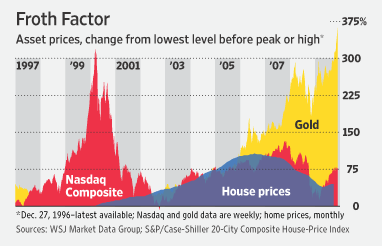“The best approach here if at all possible is to use supervisory and regulatory methods to restrain undue risk-taking and to make sure the system is resilient in case an asset price bubble bursts in the future.”
-Ben Bernanke, Federal Reserve Chairman
>
Ben Bernanke, it seems, is changing his spots. He is now trying to prove that he is not Alan Greenspan. The technique? Spotting and popping asset bubbles before they do too much damage.
This is a major change for the Fed Chairman. (Note that the Fed first floated a trial balloon on this in May 2008).
Bernanke made his Fed bones, so to speak, back in 1999, when he presented a paper to Fed officials at their annual Jackson Hole meeting, arguing against the Fed popping bubbles. His argument? The Fed should focus on controlling inflation, not trying to manage the cycle of booms and busts.
That argument resonated with Easy Al.
Under Alan Greenspan, the Fed accomplished neither goal. The various Greenspan era bubbles such as tech-stocks, credit, oil and commodities boom, and of course, housing all ran their course unabted, with no interference from the Fed. Inflation — much higher from 1999 to 2007 than CPI falsely reports — also ran wild.
Here is Jon Hilsenrath of the WSJ:
“Fed officials used to think there was little they could or should do to prevent bubbles from inflating. For one thing, identifying bubbles with any certainty was deemed to be too difficult. And even if they could be accurately pinpointed, pricking them might do more harm than good. Raising interest rates to stop a bubble, for instance, could slow growth in other parts of the economy that were otherwise healthy.
The Fed’s main strategy instead was to mop up after a bubble burst with lower interest rates to cushion the blow to the economy and restart growth. That strategy was a key conclusion of Mr. Bernanke’s writings on the subject of bubbles when he was a Princeton professor, and again when he first came to the Fed as a governor in 2002. It was an approach embraced by his predecessor Alan Greenspan.
Now, Fed officials admit the stance didn’t work. They’re groping for alternatives. Of the two methods to prevent bubbles — using regulations to protect the financial system from excess and changing monetary policy by raising interest rates — Mr. Bernanke falls on the side of greater regulation, an idea he has advocated in the past.”
Incidentally, there were few doubters about the Bernanke/Greenspan plan of allowing bubbles to run wild. William Dudley, Goldman’s chief economist, now NY Fd Prez, was one of them. Dudley has said, correctly in my opinion, that it’s not as hard to spot bubbles as many economists believe: “I can identify at least five bubbles that one could reasonably have identified in real time.”
Greenspan & Bernanke were wrong, Dudley and myself are correct: You can actually identify bubbles in real time.
Back in 2008, I suggested the Fed pay attention to the following metrics:
1. Standard Deviations of Valuation
2. Significantly elevated returns
3. Excess leverage
4. New financial products
5. Expansion of Credit
6. Trading Volumes Spike
7. Perverse Incentives
8. Tortured rationalizations
9. Unintended Consequences
10. Employment trends
The details of each of these can be found here: Can the Fed Pop Bubbles (And If So, How)?
G>

chart courtesy of WSJ
G>
Previously:
Policy Shift: Can the Fed Identify & Pop Asset Bubbles? (May 15th, 2008)
http://www.ritholtz.com/blog/2008/05/policy-shift-can-the-fed-identify-pop-asset-bubbles/
Can the Fed Pop Bubbles (And If So, How)? (October 22nd, 2008)
http://www.ritholtz.com/blog/2008/10/can-the-fed-pop-bubbles-and-if-so-how/
Source:
Fed Debates New Role: Bubble Fighter
JON HILSENRATH
WSJ,
DECEMBER 2, 2009
http://online.wsj.com/article/SB125970281466871707.html


What's been said:
Discussions found on the web: